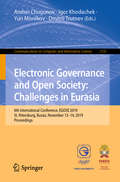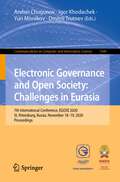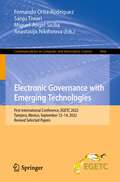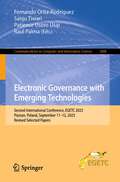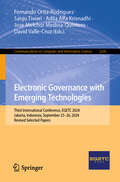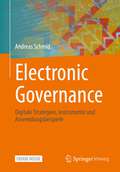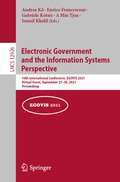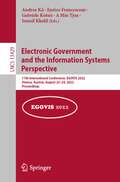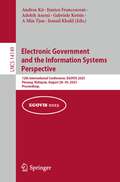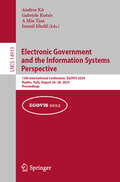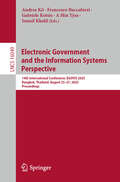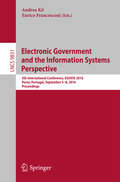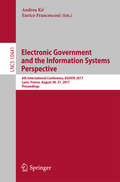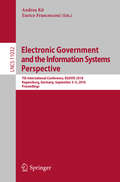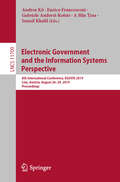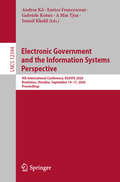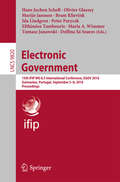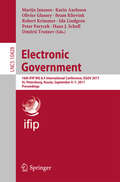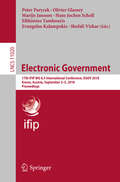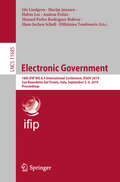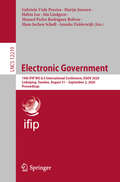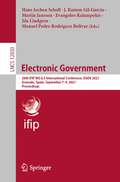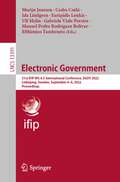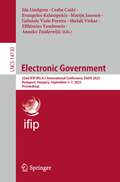- Table View
- List View
Electronic Governance and Open Society: 6th International Conference, EGOSE 2019, St. Petersburg, Russia, November 13–14, 2019, Proceedings (Communications in Computer and Information Science #1135)
by Dmitrii Trutnev Andrei Chugunov Yuri Misnikov Igor KhodachekThis book constitutes the refereed proceedings of the 6th Conference on Electronic Governance and Open Society: Challenges in Eurasia, EGOSE 2019, held in St. Petersburg, Russia, in November 2019.The 32 revised full papers were carefully reviewed and selected from 82 submissions. The papers are organized in topical sections on smart city;digital government, society and economy; digital intelligence, data science and cybercrime; social networking and media.
Electronic Governance and Open Society: 7th International Conference, EGOSE 2020, St. Petersburg, Russia, November 18–19, 2020, Proceedings (Communications in Computer and Information Science #1349)
by Dmitrii Trutnev Andrei Chugunov Yuri Misnikov Igor KhodachekThis book constitutes the refereed proceedings of the 7th Conference on Electronic Governance and Open Society: Challenges in Eurasia, EGOSE 2020, held in St. Petersburg, Russia, in November 2020.The 35 full papers and 5 short papers were carefully reviewed and selected from 59 submissions. The papers are organized in topical sections on digital government: services, policies, laws, practices, surveillance; digital society: openness, participation, trust, competences; digital data: data science, methods, modelling, AI, NLP.
Electronic Governance and Open Society: 8th International Conference, EGOSE 2021, Saint Petersburg, Russia, November 24–25, 2021, Proceedings (Communications in Computer and Information Science #1529)
by Marijn Janssen Andrei V. Chugunov Dmitrii Trutnev Yuri Misnikov Igor KhodachekThis book constitutes the refereed proceedings of the 8th Conference on Electronic Governance and Open Society: Challenges in Eurasia, EGOSE 2021, held in St. Petersburg, Russia, in November 2021.The 21 full papers were carefully reviewed and selected from 69 submissions, additionally one invited paper has been included in this volume. The papers are organized in topical sections on digital technology and design; digital Society; digital government and economy.
Electronic Governance with Emerging Technologies: First International Conference, EGETC 2022, Tampico, Mexico, September 12–14, 2022, Revised Selected Papers (Communications in Computer and Information Science #1666)
by Miguel-Angel Sicilia Sanju Tiwari Fernando Ortiz-Rodríguez Anastasija NikiforovaThis book constitutes selected and revised papers presented at the First International Conference on Electronic Governance with Emerging Technologies, EGETC 2022, held in Tampico, Mexico, in September 2022. The 15 full papers and 2 short papers presented were thoroughly reviewed and selected from the 54 submissions. This volume focuses on the recent developmentsin the domain of eGovernment and governance of digital organizations also aims to shed light on the emerging research trends and their applications.
Electronic Governance with Emerging Technologies: Second International Conference, EGETC 2023, Poznan, Poland, September 11–12, 2023, Revised Selected Papers (Communications in Computer and Information Science #1888)
by Sanju Tiwari Fernando Ortiz-Rodríguez Raul Palma Patience Usoro UsipThis book constitutes the refereed proceedings of the Second International Conference on Electronic Governance with Emerging Technologies, EGETC 2023, held in Poznan, Poland, during September 11–12, 2023.The 15 full papers and one short paper presented were thoroughly reviewed and selected from the 76 submissions. This volume focuses on the recent developments in the domain of eGovernment and governance of digital organizations also aims to shed light on the emerging research trends and their applications.
Electronic Governance with Emerging Technologies: Third International Conference, EGETC 2024, Jakarta, Indonesia, September 25–26, 2024, Revised Selected Papers (Communications in Computer and Information Science #2245)
by Sanju Tiwari Fernando Ortiz-Rodriguez Adila Alfa Krisnadhi Jose Melchor Medina-Quintero David Valle-CruzThis book constitutes the refereed proceedings of the Third International Conference on Electronic Governance with Emerging Technologies, EGETC 2024, held in Jakarta, Indonesia, during September 25–26, 2024. The 16 full papers and 1 short paper presented in this book were reviewed and selected from 50 submissions. This volume discusses the latest scientific results and technological innovations related to emerging technologies that support electronic governance. It serves as a forum for academics, scholars, and practitioners from academia and industry to share and exchange recent developments in the domain of e-government and e-governance of digital organizations. Additionally, it aims to highlight emerging research trends and their applications.
Electronic Governance: Digitale Strategien, Instrumente und Anwendungsbeispiele
by Andreas SchmidNoch nie sind die technologischen Entwicklungen und die Veränderungen der Märkte so rasant verlaufen wie heutzutage. Die Digitalisierung von Wirtschaft und Gesellschaft stehen dabei erst am Anfang. Viele Menschen beobachten die Entwicklungen misstrauisch. Sie können mit den in Verbindung stehenden Methoden und Begriffen kaum etwas anfangen. Dieses Buch schafft Abhilfe, in dem es umfassend und verständlich aufklärt und erklärt. Beispiele aus Theorie und Praxis veranschaulichen die Inhalte. Die Beherrschung der zugehörigen Komplexitäten ist noch nicht gelungen, wie z.B. die lange Liste gescheiterter Digitalisierungsvorhaben anschaulich belegt. Es geht darum, die Unternehmen zukunftsfest zu machen und die Beschäftigten zu befähigen. Hierfür braucht es einer Art digitaler bzw. technisierter „Leitplanken“, die mit einer „Electronic Governance“ entwickelt und spezifiziert werden. Es handelt sich um ein Steuerungs- und Regelungssystem, welches Organisationen und ihre Beschäftigten in Zeiten der Digitalisierung erfolgreich in die Zukunft führt.
Electronic Government and the Information Systems Perspective: 10th International Conference, EGOVIS 2021, Virtual Event, September 27–30, 2021, Proceedings (Lecture Notes in Computer Science #12926)
by Enrico Francesconi Ismail Khalil A Min Tjoa Gabriele Kotsis Andrea KöThis volume LNCS 12926 constitutes the papers of the 10th International Conference on Electronic Government and the Information Systems Perspective, EGOVIS 2021, held in September 2021 as part of the DEXA 2021 conference. The event was held virtually due to COVID-19 pandemic. The 13 full papers presented were carefully reviewed and selected from 21 submissions and focus on information systems and ICT aspects of e-government. The papers are organized in 3 topical sections: e-government theoretical background and cases; identity management and legal issues; artificial intelligence and machine learning in e-government context.
Electronic Government and the Information Systems Perspective: 11th International Conference, EGOVIS 2022, Vienna, Austria, August 22–24, 2022, Proceedings (Lecture Notes in Computer Science #13429)
by Enrico Francesconi Andrea Kő Ismail Khalil A Min Tjoa Gabriele KotsisThis volume LNCS 12429 constitutes the papers of the 11th International Conference on Electronic Government and the Information Systems Perspective, EGOVIS 20221, held in Vienna, Austria, in August 2022. The 11 full papers presented were carefully reviewed and selected from 16 submissions and focus on information systems and ICT aspects of e-government. The papers are organized in 3 topical sections: e-government theoretical background; semantic technologies and legal issues;; artificial intelligence and machine learning in e-government context.
Electronic Government and the Information Systems Perspective: 12th International Conference, EGOVIS 2023, Penang, Malaysia, August 28–30, 2023, Proceedings (Lecture Notes in Computer Science #14149)
by Enrico Francesconi Ismail Khalil A Min Tjoa Gabriele Kotsis Andrea Kö Adeleh AsemiThis book constitutes the proceedings of the 12th International Conference on Electronic Government and the Information Systems Perspective, EGOVIS 2023, which took place in Penang, Malaysia, during August 28-30, 2023.The 8 full papers presented together with 1 short paper were carefully reviewed and selected from a total of 17 submissions. They were organized in topical sections as follows: e-Government; strategy; artificial intelligence.
Electronic Government and the Information Systems Perspective: 13th International Conference, EGOVIS 2024, Naples, Italy, August 26–28, 2024, Proceedings (Lecture Notes in Computer Science #14913)
by Ismail Khalil A Min Tjoa Gabriele Kotsis Andrea KöThis book constitutes the proceedings of the 13th International Conference on Electronic Government and the Information Systems Perspective, EGOVIS 2024, which took place in Naples, Italy, in August 2024. The 10 full and 5 short papers included in this book were carefully reviewed and selected from 24 submissions. They were organized in topical sections as follows: AI in E-Government; E-Government cases; mobile government and digital inclusion; open government data and security.
Electronic Government and the Information Systems Perspective: 14th International Conference, EGOVIS 2025, Bangkok, Thailand, August 25–27, 2025, Proceedings (Lecture Notes in Computer Science #16049)
by Andrea Kő Ismail Khalil A Min Tjoa Francesco Buccafurri Gabriele KotsisThis book constitutes the proceedings of the 14th International Conference on Electronic Government and the Information Systems Perspective, EGOVIS 2025, held in Bangkok, Thailand, during August 25–27, 2025. The 11 full and 4 short papers included in the proceedings were carefully reviewed and selected from 29 submissions. They were organized in topical sections as follows: Legal Aspects and Semantic Approaches; Digital Transformation and E-government Inclusion; AI in E-Government; E-Government Cases.
Electronic Government and the Information Systems Perspective: 5th International Conference, EGOVIS 2016, Porto, Portugal, September 5-8, 2016, Proceedings (Lecture Notes in Computer Science #9831)
by Enrico Francesconi Andrea KőThis book constitutes the refereed proceedings of the 5th International Conference on Electronic Government and the Information Systems Perspective, EGOVIS 2016, held in Porto, Portugal, in September 2016, in conjunction with DEXA 2015. The 22 revised full papers presented together with three invited talk were carefully reviewed and selected from 27 submissions. The papers are organized in the following topical sections: e-government cases - legal issues; e-government cases - technical issues; open data and transparency; knowledge representation and modeling in e-government; intelligent systems in e-government; e-government research and intelligent systems; e-government data and knowledge management; identity management in e-government.
Electronic Government and the Information Systems Perspective: 6th International Conference, EGOVIS 2017, Lyon, France, August 28-31, 2017, Proceedings (Lecture Notes in Computer Science #10441)
by Enrico Francesconi Andrea KőThis book constitutes the refereed proceedings of the 6th International Conference on Electronic Government and the Information Systems Perspective, EGOVIS 2017, held in Lyon, France, in August 2017. The 20 revised full papers presented were carefully reviewed and selected from 24 submissions. The papers areorganized in the following topical sections: digitalization and transparency; open data ecosystems; intelligent systems in e-government; e-government research and intelligent systems; m-government and inclusion; e-government cases - data knowledge management; and knowledge management in the context of e-government.
Electronic Government and the Information Systems Perspective: 7th International Conference, EGOVIS 2018, Regensburg, Germany, September 3–5, 2018, Proceedings (Lecture Notes in Computer Science #11032)
by Enrico Francesconi Andrea KőThis book constitutes the refereed proceedings of the 7th International Conference on Electronic Government and the Information Systems Perspective, EGOVIS 2018, held in Regensburg, Germany, in September 2018. The 19 revised full papers presented were carefully reviewed and selected from 22 submissions. The papers are organized in the following topical sections: digitalization and transparency; challenges in e-government technology and e-voting; knowledge management in the context of e-government; semantic technologies and the legal aspects; open data and open innovation; and e-government cases - data and knowledge management.
Electronic Government and the Information Systems Perspective: 8th International Conference, EGOVIS 2019, Linz, Austria, August 26–29, 2019, Proceedings (Lecture Notes in Computer Science #11709)
by Enrico Francesconi Andrea Kő Ismail Khalil A Min Tjoa Gabriele Anderst-KotsisThis book constitutes the refereed proceedings of the 8th International Conference on Electronic Government and the Information Systems Perspective, EGOVIS 2019, held in Linz, Austria, in August 2019. The 17 full papers presented were carefully reviewed and selected from 25 submissions. The papers are organized in the following topical sections: open data and open innovation; data-driven approaches in e-government; e-government cases – data and knowledge management; e-government theoretical background; and digitalization and transparency.
Electronic Government and the Information Systems Perspective: 9th International Conference, EGOVIS 2020, Bratislava, Slovakia, September 14–17, 2020, Proceedings (Lecture Notes in Computer Science #12394)
by Enrico Francesconi Andrea Kő Ismail Khalil A Min Tjoa Gabriele KotsisThis book constitutes the refereed proceedings of the 9th International Conference on Electronic Government and the Information Systems Perspective, EGOVIS 2020, held in Bratislava, Slovakia, in September 2020. The 15 full and one short papers presented were carefully reviewed and selected from 24 submissions. The papers are organized in the following topical sections: Knowledge representation and modeling in e-Government; e-Government theoretical background; E-Government cases - data and knowledge management; identity management and legal issues; artificial intelligence and machine learning in e-Government context.
Electronic Government: 15th IFIP WG 8.5 International Conference, EGOV 2016, Guimarães, Portugal, September 5-8, 2016, Proceedings (Lecture Notes in Computer Science #9820)
by Efthimios Tambouris Maria A. Wimmer Delfina Sá Soares Tomasz Janowski Hans Jochen Scholl Marijn Janssen Bram Klievink Ida Lindgren Peter Parycek Olivier GlasseyThis book constitutes the refereed proceedings of the 15th IFIP WG 8.5 International Conference on Electronic Government, EGOV 2016, held in Guimaraes, Portugal, in September 2016, in conjunction with the 8th International Conference on eParticipation, ePart 2016. The 24 revised full papers presented were carefully reviewed and selected from 87 submissions. The papers are clustered under the following topical sections: foundations; benchmarking and evaluation; information integration and governance; services; evaluation and public values; EGOV success and failure; governance; social media; engagement; processes; policy-making; trust, transparency and accountability; open government and big/open data; smart government/governance/cities.
Electronic Government: 16th IFIP WG 8.5 International Conference, EGOV 2017, St. Petersburg, Russia, September 4-7, 2017, Proceedings (Lecture Notes in Computer Science #10428)
by Marijn Janssen, Karin Axelsson, Olivier Glassey, Bram Klievink, Robert Krimmer, Ida Lindgren, Peter Parycek, Hans J. Scholl and Dmitrii TrutnevThis book constitutes the proceedings of the 16th IFIP WG 8.5 International Conference on Electronic Government, EGOV 2017, held in St. Petersburg, Russia, in September 2017, in conjunction with the 9th International Conference on eParticipation, ePart 2017.The 34 revised full papers presented were carefully reviewed and selected from 74 submissions. The papers are clustered under the following topical sections: Smart Governance, Government and Cities; Service delivery; Organizational aspects; Infrastructures; Big and Open Linked Data; Open Government; and Evaluation.
Electronic Government: 17th IFIP WG 8.5 International Conference, EGOV 2018, Krems, Austria, September 3-5, 2018, Proceedings (Lecture Notes in Computer Science #11020)
by Efthimios Tambouris Hans Jochen Scholl Marijn Janssen Peter Parycek Olivier Glassey Evangelos Kalampokis Shefali VirkarThis book constitutes the proceedings of the 17th IFIP WG 8.5 International Conference on Electronic Government, EGOV 2018, held in Krems, Austria, in September 2018, in conjunction with the 10th International Conference on eParticipation, ePart 2018.The 22 revised full papers presented were carefully reviewed and selected from 48 submissions. The papers are clustered under the following topical sections: General E-Government and Open Government; Open Data, Linked Data, and Semantic Web; Smart Governance (Government, Cities and Regions); and Artificial Intelligence, Data Analytics and Automated Decision-Making.
Electronic Government: 18th IFIP WG 8.5 International Conference, EGOV 2019, San Benedetto Del Tronto, Italy, September 2–4, 2019, Proceedings (Lecture Notes in Computer Science #11685)
by Efthimios Tambouris Hans Jochen Scholl Marijn Janssen Ida Lindgren Manuel Pedro Rodríguez Bolívar Habin Lee Andrea PoliniThis book constitutes the proceedings of the 18th IFIP WG 8.5 International Conference on Electronic Government, EGOV 2019, held in San Benedetto del Tronto, Italy, in September 2019, in conjunction with the IFIP WG 8.5 IFIP International Conference on Electronic Participation (ePart 2019) and the International Conference for E-Democracy and Open Government Conference (CeDEM 2019).The 27 revised full papers presented were carefully reviewed and selected from 64 submissions. The papers are clustered under the following topical sections: E-Government Foundations; E-Government Services and Open Government; Open Data: Social and Technical Aspects; AI, Data Analytics and Automated Decision Making; and Smart Cities.
Electronic Government: 19th IFIP WG 8.5 International Conference, EGOV 2020, Linköping, Sweden, August 31 – September 2, 2020, Proceedings (Lecture Notes in Computer Science #12219)
by Hans Jochen Scholl Marijn Janssen Ida Lindgren Anneke Zuiderwijk Manuel Pedro Rodríguez Bolívar Habin Lee Gabriela Viale PereiraThis book constitutes the proceedings of the 19th IFIP WG 8.5 International Conference on Electronic Government, EGOV 2020, held in Linköping, Sweden, in August/September 2020, in conjunction with the IFIP WG 8.5 IFIP International Conference on Electronic Participation (ePart 2020) and the International Conference for E-Democracy and Open Government Conference (CeDEM 2020). The conference was held virtually due to the COVID-19 pandemic. The 30 full papers presented were carefully reviewed and selected from 118 submissions. The papers are clustered under the following topical sections: e-government foundations; e-government services and open government; open data: social and technical aspects; AI, data analytics, and automated decision making; and smart cities.
Electronic Government: 20th IFIP WG 8.5 International Conference, EGOV 2021, Granada, Spain, September 7–9, 2021, Proceedings (Lecture Notes in Computer Science #12850)
by J. Ramon Gil-Garcia Hans Jochen Scholl Marijn Janssen Ida Lindgren Manuel Pedro Rodríguez Bolívar Evangelos KalampokisThis book constitutes the proceedings of the 20th IFIP WG 8.5 International Conference on Electronic Government, EGOV 2021, held in Granada, Spain, in September 2021, in conjunction with the IFIP WG 8.5 IFIP International Conference on Electronic Participation (ePart 2021) and the International Conference for E-Democracy and Open Government Conference (CeDEM 2021).The 23 full papers presented were carefully reviewed and selected from 63 submissions. The papers are clustered under the following topical sections: digital transformation; digital services and open government; open data: social and technical perspectives; smart cities; and data analytics, decision making, and artificial intelligence. Chapters "Perceived and Actual Lock-in Effects Amongst Swedish Public Sector Organisations when Using a SaaS Solution" and "Ronda: Real-time Data Provision, Processing and Publication for Open Data" are available open access under a Creative Commons Attribution 4.0 International License via link.springer.com.
Electronic Government: 21st IFIP WG 8.5 International Conference, EGOV 2022, Linköping, Sweden, September 6–8, 2022, Proceedings (Lecture Notes in Computer Science #13391)
by Efthimios Tambouris Marijn Janssen Ida Lindgren Manuel Pedro Rodríguez Bolívar Gabriela Viale Pereira Csaba Csáki Ulf Melin Euripidis LoukisThis book constitutes the proceedings of the 21st IFIP WG 8.5 International Conference on Electronic Government, EGOV 2022, held in Linköping, Sweden, in September 2022.Chapters “Use of Commercial SaaS Solutions in Swedish Public Sector Organisations under Unknown Contract Terms”, “Towards a Research Agenda for Personal Data Spaces: Synthesis of a Community Driven Process” and “Adapting a Faceted Search Task Model for the Development of a Domain-Specific Council Information Search Engine” are available open access under a Creative Commons Attribution 4.0 International License via link.springer.com.
Electronic Government: 22nd IFIP WG 8.5 International Conference, EGOV 2023, Budapest, Hungary, September 5–7, 2023, Proceedings (Lecture Notes in Computer Science #14130)
by Efthimios Tambouris Marijn Janssen Ida Lindgren Anneke Zuiderwijk Evangelos Kalampokis Shefali Virkar Gabriela Viale Pereira Csaba CsákiThis book constitutes the proceedings of the 22nd IFIP WG 8.5 International Conference on Electronic Government, EGOV 2023, which took place in Budapest, Hungary, during September 5–7, 2023.The 28 full papers included in this book were carefully reviewed and selected from a total of 106 submissions. They were organized in topical sections as follows: Digital government; artificial intelligence, algorithms, and automation; open government and open data; smart cities, regions, and societies; innovation and transformation in government.
